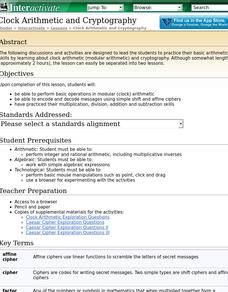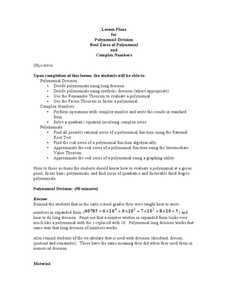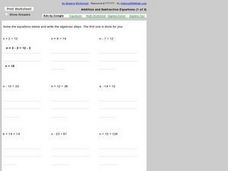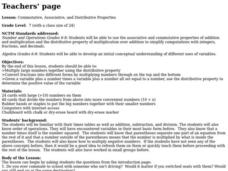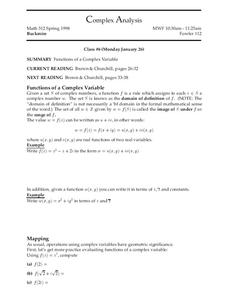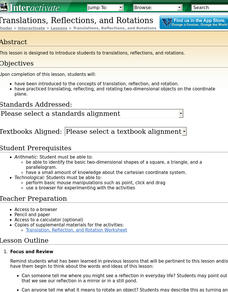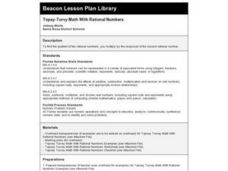Curated OER
Spiders - KidPix
Students answer questions after a story is read aloud, identify and recall the three major body parts of a spider (head, body and 8 legs), construct a spider when given parts of a spider on a handout, and draw and decorate a spider using...
Curated OER
Comprehension of Word Problems
Students solve word problems using a graphic organizer. In this problem solving lesson, students are introduced to the included graphic organizer and are taught how to use it for solving word problems. Students write the required...
Curated OER
The Real Work is Done in Committee: A Simulation
Young scholars research the Canadian federal legislative process, and identify the main features of local, provincial, and federal governments in Canada. They simulate the process of a bill going through the legislative process.
Curated OER
Using Inequalities to Problem Solve
Students explore inequalities. In this Algebra I lesson, students solve and graph linear inequalities involving addition, subtraction, multiplication, or division. Students use inequalities to solve and graph real-world problems.
Pennsylvania Department of Education
Adding and Subtracting Rational Numbers to Solve Problems
High schoolers explore the concept of probability. In this probability lesson, students use area to determine probability. High schoolers use charts and spinners to help determine the probability of events such as flipping a...
Curated OER
The School Store
Learners choose between the operations of addition or subtraction to solve a real life problem. In this addition and subtraction lesson plan, students make a chart of items sold in the school store. Learners then work in teams to apply...
Curated OER
Clock Arithmetic and Cryptography
Students investigate modular clock arithmetic and cryptography. They perform basic operations in modular (clock) arithmetic and encode and decode messages using simple shift and affine ciphers.
Curated OER
The football and Braking Distance; Model Data with Quadratic Functions
Learners use the quadratic formula to solve application problems. The first problem relates to the path of a football thrown from the top of the bleachers. Students compute the time it will take the football to reach certain heights. In...
Curated OER
Polynomial Divisions
Students factor polynomials and use long division t solve problems. In this algebra lesson, students find the zeros of polynomials by synthetic and long division. They perform operation using complex numbers.
Curated OER
Colorful Solutions
Fourth graders complete a coloring activity and consider where like fractions are actually used in real-life situations. They problem solve in groups using fractions with common denominators.
Curated OER
Integers and Fractions
Students perform operations using positive and negative numbers as well as operations with fractions in various forms. They identify common decimals and their fraction equivalents while converting fractions to decimal form.
Curated OER
Fielding Fears
Pupils consider how real the threat of terrorism might be after military operations in Afghanistan and Iraq, and then explore the terrorist attacks of May, 2003.
Curated OER
Complex Numbers
In this complex numbers learning exercise, students simplify 9 problems involving the addition, subtraction, multiplication, and division of complex numbers.
Helping with Math
#5: Addition & Subtraction Equations (1 of 2)
Single-step addition or subtraction operations are applied in order to solve these 12 simple equations. An answer key is available, not so much for you, but perhaps to be used by learners as a self-correction tool. Note that the...
Helping with Math
#10: Solving Equations (2 of 2)
In this prealgebra activity, pupils perform addition, subtraction, multiplication, or division operations to solve for an unknown. There are 12 problems to be solved. Use this as a quiz to assess how well your class is grasping the skill...
Curated OER
Commutative, Associative, and Distributive Properties
Students explore the concept of the associative, commutative, and distributive properties. In the associative, commutative, and distributive properties lesson, students discuss real world examples of each property. Students demonstrate...
Curated OER
Layers Upon Layers
Students model how layers of sediments are deposited. They use logic to derive rules or laws that can be used to examine layers of sediment in a cup and apply it to the real world.
Curated OER
Understanding Radios
Fifth graders explore ratios. Using models and real-world scenarios, they complete tables and generate comparisons. Pupils demonstrate multiple ways of writing ratios and describe the differences between ratios.
Alabama Learning Exchange
Find a Pattern Using Children's Literature
Sixth graders listen to Demi's, On Grain of Rice: A Mathematical Folktale. They use the problem solving strategy of finding a pattern to determine the number of rice Rani will receive after 30 days. They create a spreadsheet which...
Curated OER
Complex Analysis: Functions of Complex Variables
For this function worksheet, students map equations and identify three dominant characteristics. They evaluate functions of complex variables. This three-page worksheet contains approximately ten problems.
Curated OER
Translations, Reflections, and Rotations
Tenth graders have been introduced to the concepts of translation, reflection, and rotation, and have practiced translating, reflecting, and rotating two-dimensional objects on the coordinate plane.
Curated OER
Topsy-Turvy Math With Rational Numbers
Fourth graders complete a worksheet. As a whole class, 4th graders hear a lecture and complete a worksheet on factors, multiplicative inverses and reciprocals, finding the quotient of two fractions and the division of fractions to...
Curated OER
The Price Is Right - Grocery Store Prices
Eighth graders use the unit price to compare which local grocery store has the best prices. Assign students to work with a partner and a role. One person is the recorder and the other is the mathematician.
Curated OER
Supply and Demand
Students access a tutorial website entitled "Supply and Demand," and participate in interactive activities in the computer lab. They read two articles and complete a post test experience.








